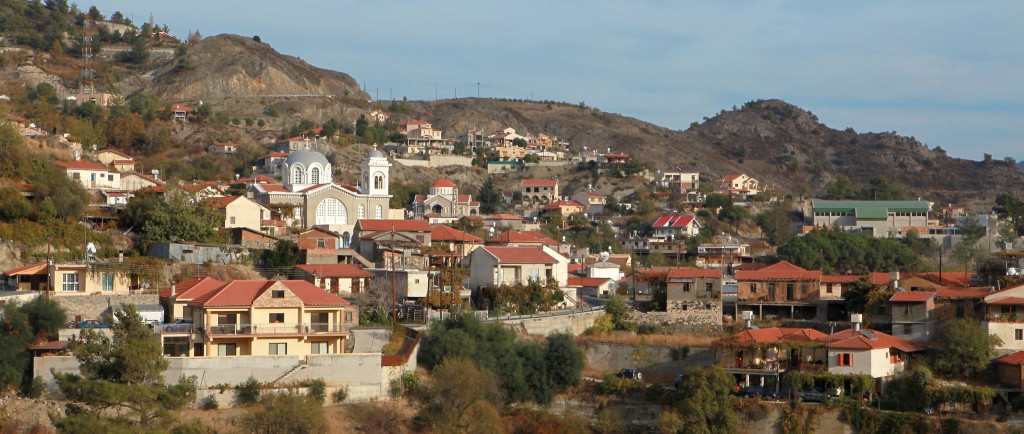The village is located on one of the slopes of the Troodos mountain region, about 40 km from Limassol and at a sufficiently great distance from the coast. Since the village is situated at an altitude of 880 m above sea level, in the summer here it is a little cooler than in the coastal areas and, in addition, there is no humidity. Therefore, those tourists who want a break from the sweltering heat and plan to make an educational excursion, must come here.
The medieval roots of Pelendri
An interesting fact is the story of the village, which dates back to the Middle Ages. Documents show that in the XIV century it was a feudal estate of the son of the King of Cyprus, Hugo IV of Jean de Lusignan.
There are several versions about the origin of the name Pelendri. Some historians believe that the village received its name because of the herb Felandrio, small white fragrant flowers, which grow in abundance in the area. Others believe that the name was consonant with a local type of mushroom known as Pelendri, although there is also the opposite view that the name was inherited from the village to the mushroom. According to another version, the village was called Pelendri by the name of the family who owned it in the Middle Ages. So, describing the reign of the island of Lusignan, the known chronicler of Cyprus Leontis Maheras mentions seven Pelentri places. Finally, the last point of view on the origin of the name of the village celebrates its similarity to the word “polidendri”, which translated from Greek means “a lot of trees” as the large number of trees in the village.
Traditional agricultural production
The number of locals now is about one and a half thousand people. According to Cypriot standards it is quite a large settlement. Most of the inhabitants are engaged in agriculture, growing fruit trees and vegetables in gardens and in the fields, which are growing in abundance in the region; these include tomatoes, cucumbers and potatoes, olives and almonds, walnuts and legumes, as well as grapes, subsequently supplied to the many wineries in the region.
Pelendri is a very picturesque village, where old buildings are preserved, which are typical examples of traditional rural architecture in Cyprus. On a warm, but not hot day it is very pleasant to wander through the narrow streets, admire the gardens and flower beds at the houses, observe the life of the locals.
Timios Stavros church
Pelendri is also famous for its unique church. A particularly interesting one, which is included in the list of the ten churches in Cyprus, which are recognized by UNESCO as part of world cultural heritage. This is the church of the Holy Cross (Timios Stavros), founded in the XII century (1178). Originally the church was of a single-nave, but for unknown reasons it was destroyed, and later a new three-nave church was built in the XIV century in the place of the old church. Later in the century to the northern part of the church the first chapel was added and then in the XVI century there was another chapel with an arch in the southern part of the church.
For whatever reasons, the northern part of the chapel collapsed with time, and only the paintings on the western and southern walls and the bottom of the eastern wall have survived.
Currently Timios Stavros is a three-nave church with murals on the eastern side of the central aisle. The arches are covered with a pitched slate roof, which was recently renovated.
The main part of the church is decorated with wall murals, created in the first half of the XIV century by three artists. The first of them adhered to the paleologan style, which emerged in Constantinople in the XIII century, the second followed a less complex and more schematic style, which was introduced in the XIV century and the third kept the tradition of Byzantine painting with oriental elements.
Most likely, when you come to the church, it will be closed, but do not worry. Once you spend just a few minutes at the church, the housekeeper will miraculously appear there and the doors swing open in front of you into church. Well, if he does not appear, contact one of the neighboring houses, and the local guard will gladly help you and open the church.
The church of the Holy Cross is not the only one in the village. Another old church is Panagia Catholiki (Virgin Mary’s church), which was built in the XVI century and is famous for its murals in the Byzantine style. From a distance you will see a large dome of the modern village church of St. John Lampadistis that is most loved by the locals and next to which is also the temple of Archangel Michael.
Real Cypriot coffee and lunch at a rustic tavern
After a long walk through the village, you can continue your journey and visit the nearby settlement Kiperounda, Agros or Potamistissa, and can take a break in the shade of the trees in one of the rustic taverns or cafes, enjoying strong and fragrant Cyprus coffee or a full meal. Well, we’re going home, carrying with us, as always, unique footage and amazing memories of the trip to the village that will remain for years.
